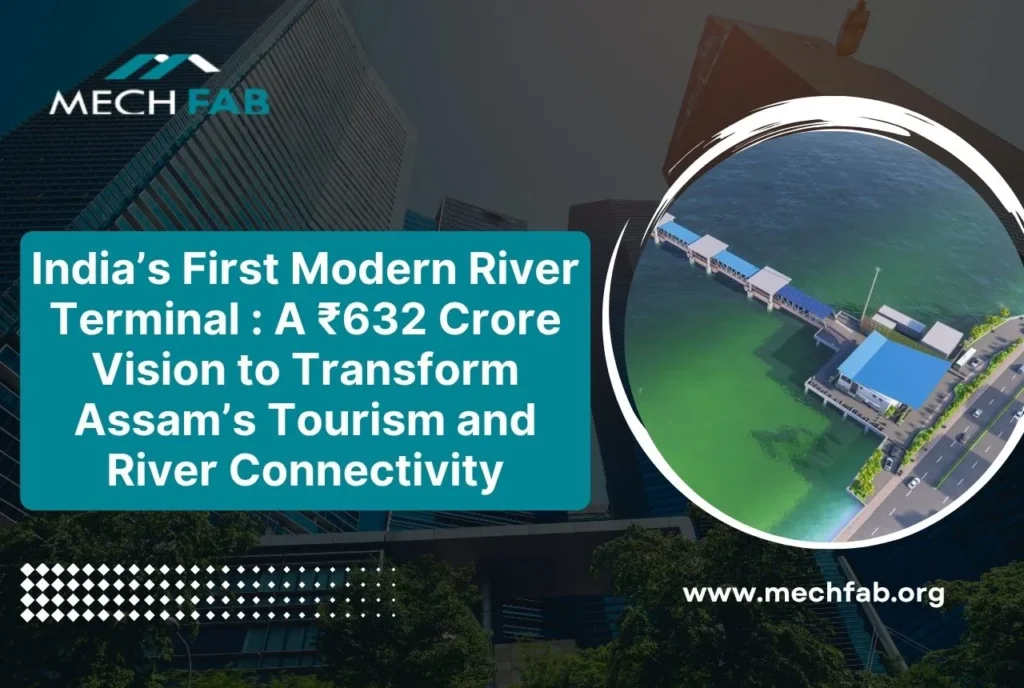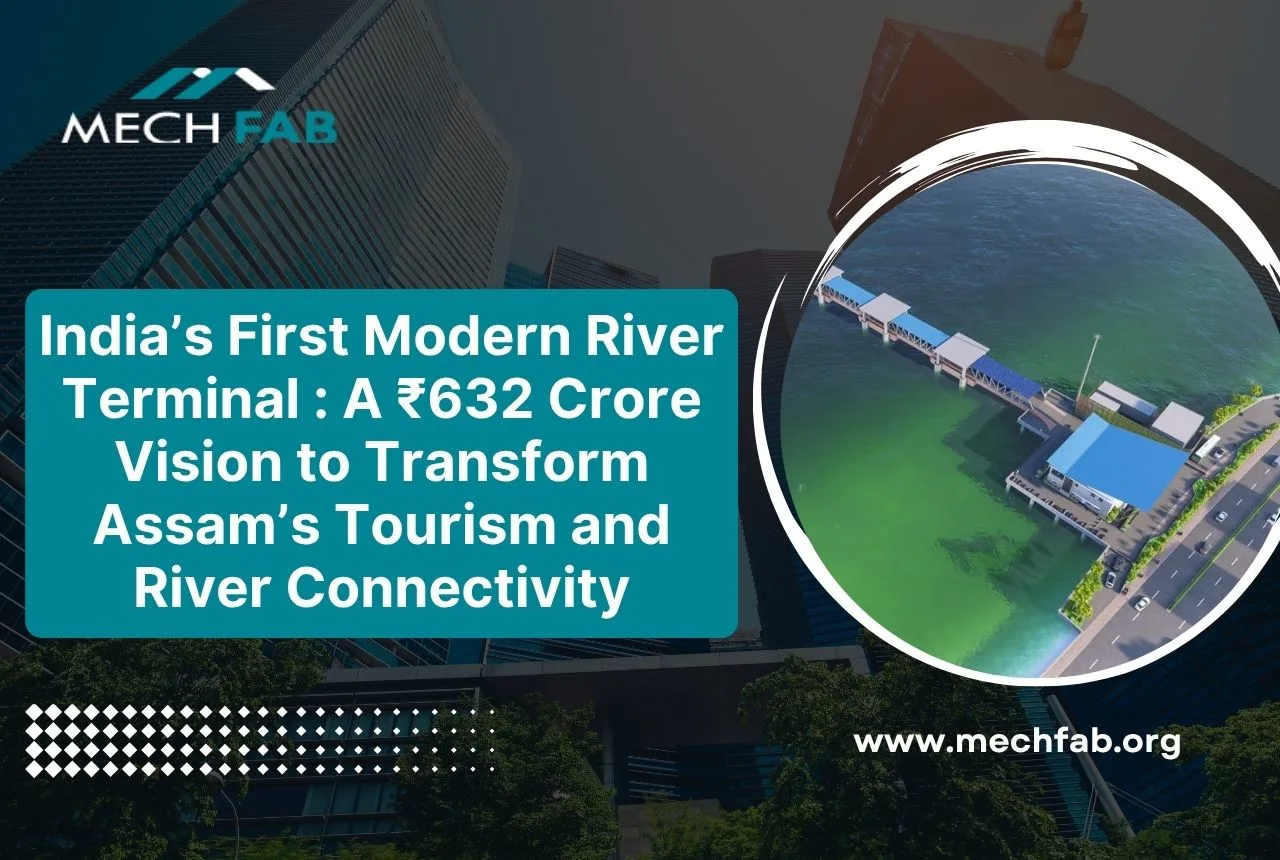Discover how India’s first modern river terminal in Guwahati, Assam- a ₹632 crore world-class project on the Brahmaputra River- is set to revolutionize river tourism, transport, and regional development. Learn how this landmark initiative positions Assam as the new hub of sustainable tourism and waterway innovation.
Introduction: A New Dawn for River Tourism in India
The story of India’s first modern river terminal is one of vision, progress, and transformation. Rising gracefully on the banks of the majestic Brahmaputra River in Guwahati, Assam, this ₹632 crore project marks a defining moment in the evolution of India’s inland waterways. It represents a bold move towards sustainable development — combining modern infrastructure, environmental consciousness, and tourism potential into one integrated ecosystem.
Unveiled recently with national attention, India’s first modern river terminal is not just a transport hub; it’s a symbol of how the Northeast is embracing modernity while staying rooted in its natural and cultural identity. With cutting-edge architecture, state-of-the-art facilities, and tourism-friendly design, it stands poised to make Assam a global river tourism destination.
The Vision Behind India’s First Modern River Terminal
India’s inland waterways have long remained an untapped resource. Despite having over 14,000 km of navigable rivers and canals, river-based transport and tourism lagged behind road and air networks. The Government of India, in collaboration with the Assam government and the World Bank, recognized this gap and launched a visionary plan to modernize river transport in the Northeast.
At the heart of that vision is India’s first modern river terminal, conceived not merely as a passenger terminal but as a “Gateway to Guwahati” — a blend of transportation, tourism, leisure, and heritage.
The ₹632 crore investment embodies a forward-looking approach to urban and ecological design. The project integrates flood-resilient construction, modern passenger lounges, floating jetties, cafes, vehicle parking, information centers, and docking zones — all aligned with global sustainability standards.
Project Overview: Key Features of the Terminal
The creation of India’s first modern river terminal has set new benchmarks in inland waterway infrastructure. Here’s what makes it special:
- Strategic Location: Built in Guwahati — Assam’s most vibrant urban center — the terminal connects key river routes across the Brahmaputra and nearby districts.
- Design Excellence: The terminal’s architecture merges functionality with aesthetics — featuring floating pontoons, climate-adaptive design, and panoramic viewing decks that highlight the beauty of the river.
- World-Class Amenities: From air-conditioned waiting lounges and ticketing counters to accessible ramps, the terminal prioritizes passenger comfort and inclusivity.
- Eco-Friendly Infrastructure: Solar energy integration, wastewater recycling systems, and green landscaping reflect its sustainable vision.
- Tourism-Focused Facilities: Cafes, souvenir shops, and viewing decks encourage longer tourist engagement. Future plans include organizing short river cruises and water-sports experiences from the same terminal.
- Integrated Control System: A command center ensures real-time monitoring for passenger safety, vessel coordination, and environmental management.
Every design choice reaffirms the project’s dual goal — improving connectivity while enhancing the visitor experience.
Why Assam? The Strategic and Cultural Significance
Assam, with its legendary Brahmaputra River, has always been the cultural heart of Northeast India. Yet, its tourism potential along the river remained underutilized. With India’s first modern river terminal, that is set to change.
The terminal aims to transform the Brahmaputra into a vibrant economic and cultural corridor — linking cities, rural communities, and natural attractions through river routes. It will serve as both a transportation gateway and a tourist magnet, attracting domestic and international travelers to Assam’s unique riverine landscapes.
How the Terminal Will Boost Assam’s Tourism
1. Creating a New Tourism Landmark
As India’s first modern river terminal, the project is expected to become an attraction in itself. Its design, functionality, and scenic location make it a must-visit destination for tourists in Guwahati.
2. Enabling River Cruises and Cultural Tours
The terminal opens the door for luxury and mid-range cruise operators to introduce short and long-distance Brahmaputra cruises — combining sightseeing, cuisine, and cultural performances.
3. Promoting Local Art and Entrepreneurship
With more tourist traffic, local businesses — from handloom artisans to food vendors — will benefit. The terminal will create a marketplace for Assam’s traditional products, helping local livelihoods flourish.
4. Improving Regional Accessibility
For travelers heading to Majuli, Kaziranga, or Umananda Island, the river terminal will serve as a major transit hub, linking roads, ferries, and future cruise services.
5. Branding Assam as a River Tourism Destination
“India’s first modern river terminal” is a powerful brand in itself — one that positions Assam as the pioneer of modern waterway tourism in India. This distinction enhances the state’s visibility across national and international tourism campaigns.
Economic and Social Impact
The terminal is not only an engineering marvel but also an economic multiplier. It is expected to:
- Generate thousands of direct and indirect jobs in operations, tourism, logistics, and hospitality.
- Boost small businesses, transport operators, and cultural industries.
- Encourage investment in river-front real estate and tourism infrastructure.
- Inspire future waterway development projects across the Northeast.
As India’s first modern river terminal, it sets a precedent for combining development with sustainability and inclusivity.
Challenges and Sustainability
Every great infrastructure project comes with challenges. For the Brahmaputra River — known for its dynamic flow and seasonal flooding — resilience is key. Engineers have designed the terminal with floating jetties and adaptive docking systems to maintain usability even during fluctuating water levels.
Environmental safeguards, biodiversity protection, and waste management will remain continuous priorities. Regular monitoring and community involvement will ensure the terminal operates responsibly, preserving Assam’s natural ecosystem.
The Road Ahead: A Model for India’s Waterway Revolution
The success of India’s first modern river terminal could inspire similar developments in other river-rich regions like West Bengal, Bihar, and Uttar Pradesh. By promoting eco-friendly, water-based transport, India can reduce road congestion, lower carbon emissions, and foster new tourism corridors.
For Assam, the journey has just begun. The Brahmaputra — once seen only as a powerful natural force — is now being rediscovered as a channel of opportunity and connection. The Guwahati terminal stands as the symbol of this new era.
Conclusion: A Landmark for the Future
The unveiling of India’s first modern river terminal marks a turning point not just for Assam but for the entire country. It’s more than a transport facility — it’s a story of vision, resilience, and progress.
With its blend of innovation, tourism potential, and environmental sensitivity, the project redefines what modern infrastructure can achieve. It embodies India’s ambition to balance development with sustainability and to celebrate the power of its natural waterways.
As the Brahmaputra flows past Guwahati — carrying centuries of history and culture — this new terminal stands proudly on its banks as a gateway to the future.






